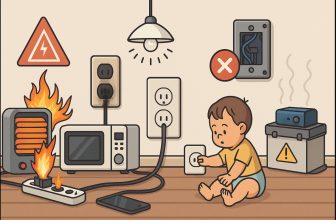You may not realize it, but some of the most routine products in your home could be quietly harming the environment. In Indian households, convenience often takes priority—but many of these everyday items come at a long-term cost to nature. From cleaning agents to personal care products, some of the most commonly used materials are non-biodegradable, chemical-heavy, or energy-intensive to produce.
Here are 13 such products that are damaging the environment and the practical, affordable alternatives you can start using today.
1. Plastic Carry Bags
Despite state-level bans, plastic carry bags are still used at kirana shops, markets, and food stalls. These thin bags clog drains, pollute rivers, and take hundreds of years to break down.
What to use instead:
Reusable cloth, canvas, or jute bags, they’re sturdier, washable, and last for years.
2. Single-Use Plastic Cutlery and Plates
Disposable spoons, forks, and plates are still common at functions and roadside stalls. They’re rarely recycled and often end up in landfills or open spaces.
What to use instead:
Opt for biodegradable areca plates or reusable steel utensils. For events, rent cutlery instead of buying disposables.
3. Chemical Floor and Toilet Cleaners
Popular branded cleaners may look effective but often contain phosphates, bleach, or synthetic fragrances that pollute water bodies and harm aquatic life.
What to use instead:
Eco-friendly floor cleaners made from bio-enzymes, vinegar, neem, or citrus extracts.
4. Laundry Detergents with Phosphates
Mainstream laundry powders contain phosphates that lead to water pollution and foam build-up in rivers and lakes.
What to use instead:
Choose detergent brands that are explicitly phosphate-free or use soap nuts and natural laundry powders.
5. Disposable Sanitary Pads and Diapers
These items are mostly made of plastic and chemical gels, creating massive landfill waste that doesn’t degrade for hundreds of years.
What to use instead:
Cloth pads, menstrual cups, or reusable cloth diapers—they’re safer for your body and the planet.
6. Aerosol Sprays and Air Fresheners
These sprays release volatile organic compounds (VOCs) that worsen indoor air quality and contribute to outdoor pollution.
What to use instead:
Natural air fresheners using essential oils, dried herbs, baking soda, or camphor.
7. Scratched Non-Stick Cookware
Old Teflon pans that are flaking release microplastics into food and the environment when discarded.
What to use instead:
Switch to cast iron, clay, or high-grade stainless steel cookware for longevity and safety.
8. Plastic Cling Wrap
Used to cover leftovers or lunchboxes, plastic wrap is thin, unrecyclable, and almost always ends up as waste.
What to use instead:
Beeswax wraps, reusable silicone lids, or simple cloth bowl covers.
9. Cosmetics with Microbeads
Many fairness creams, scrubs, and face washes use plastic microbeads that enter water bodies and harm marine ecosystems.
What to use instead:
Natural exfoliants like walnut shell powder, oats, or gram flour (besan) do the job—minus the pollution.
10. Low-Quality Plastic Buckets, Mugs, and Pipes
Cheap plastic products crack easily and are quickly discarded, adding to long-term plastic waste.
What to use instead:
Invest in high-quality plastic only if needed, or opt for durable stainless steel, copper, or bamboo-based alternatives.
11. Plastic Toothbrushes
Every plastic toothbrush you’ve used still exists somewhere. Millions are thrown away each year across India alone.
What to use instead:
Use bamboo toothbrushes with compostable handles. They last just as long and break down naturally.
12. Synthetic Mosquito Repellents and Coils
These products release fumes and particulates that harm indoor air and may cause respiratory irritation.
What to use instead:
Try neem oil, citronella, or eucalyptus-based repellents. Mosquito nets remain one of the safest solutions.
13. Bottled Water and Plastic Water Jars
Plastic water bottles, especially the 20-litre jars used in homes and offices, often degrade with reuse and contribute to massive plastic waste.
What to use instead:
Install a water purifier and use stainless steel, copper, or glass containers for storage.
Quick Checklist: Eco-Friendly Alternatives for Indian Homes
| Harmful Product | What to Use Instead |
|---|---|
| Plastic carry bags | Cloth or jute bags |
| Single-use cutlery and plates | Areca leaf plates, steel utensils |
| Chemical floor and toilet cleaners | Bio-enzyme or natural cleaners (vinegar, neem) |
| Phosphate-based laundry detergents | Eco-friendly or natural detergents |
| Disposable sanitary pads and diapers | Cloth pads, menstrual cups, reusable diapers |
| Aerosol air fresheners | Essential oil diffusers, baking soda, camphor |
| Scratched non-stick cookware | Cast iron, stainless steel, or clay cookware |
| Plastic cling wrap | Beeswax wraps, reusable lids |
| Cosmetics with microbeads | Herbal scrubs with besan, oats, or walnut shell |
| Low-quality plastic items | Durable steel, bamboo, or high-grade plastic |
| Plastic toothbrushes | Bamboo toothbrushes |
| Mosquito coils and synthetic repellents | Neem oil, citronella, mosquito nets |
| Bottled plastic water containers | Steel or glass bottles, water purifiers at home |
Want to Make a Difference? Start Here:
- Switch one product per month for a more eco-friendly version.
- Buy fewer, better-quality items that last longer.
- Talk to your family and household helpers about these changes.
- Look for Indian brands offering sustainable options.
Summary – Products That Seem Normal but Are Environmentally Harmful
These 13 products may seem ordinary, but their environmental impact adds up quickly—especially in a country as populous as India. The good news is, alternatives exist for almost every one of them. Shifting to eco-friendly options doesn’t require drastic changes—just mindful choices. Start small, act consistently, and your home can become a more sustainable place for both you and the planet.





